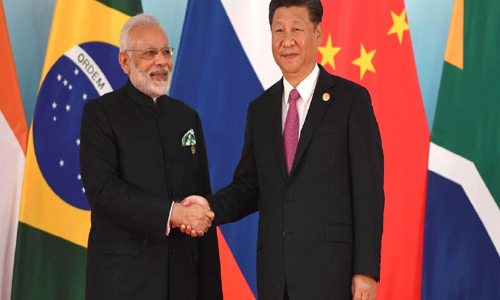Sino-India ties: Points to ponder

Harvards Graham Allison has called China the most protectionist, mercantilist and predatory major economy in the worldChina is the second largest economy in the world with capitalisation of over 11 trillion whereas India is the seventh largest with a corresponding figure of around 225 trillionIndias trade deficit with China is greater than that of America and, in terms of what it exports
Harvard’s Graham Allison has called China “the most protectionist, mercantilist and predatory major economy in the world”.China is the second largest economy in the world with capitalisation of over $11 trillion whereas India is the seventh largest with a corresponding figure of around $ 2.25 trillion.India’s trade deficit with China is greater than that of America and, in terms of what it exports to and imports from China, little different from any African economy.
The lopsided trade relationship is making India essentially a colonial – style raw – material appendage of the State – led Chinese economy.And India’s China problem will only exacerbate once the 16 – nation Regional Comprehensive Economic Partnership accord takes effect, creating a free – trade zone between the two countries.Analysts agree that the main difference between India and China is one of long-term vision and strategy.
While the thread from the quintessential communist days continues in the national security and defence sectors in China, in industrial production, the country has shown great flexibility, especially in the wake of the collapse of the erstwhile USSR. In most fastmoving consumer goods, Chinese brand identities have become household names all over the world.In India, on the other hand, R&D has been given little prominence. One hardly hears of any globally prominent television or refrigerator manufacturer anymore.
Wipro and HCL, for instance, have closed their computer lines. The fact that China has a single party, and a single system government, with no federal set up worth the name to contend with, no doubt, helps in the formulation as well as the implementation of policies. Also, human rights being not a serious issue with the government and the restrictive labour regulations naturally mean less social disturbances and more industrial tranquility. And the policy of concentrating more on the manufacturing sector than the services sector has proved to be a consolidating factor for the economy in general.
China is waging an unconventional war, albeit through economic means, inflicting greater damage by killing Indian manufacturing and fostering rising joblessness among the Indian youth, than the war by terror of Pakistan? India’s choice of strategy is not stagnant but needs to be based on the prevailing balance. If this changes, the strategy also has to change. For example, if India’s power were to become roughly compatible with China’s, India would not even need alliances but could balance China with its own internal resources (though partnerships may reduce the burden).
Experts recognise that no purpose will be served for either country by a direct military conflict. Which is why it is felt that Beijing and New Delhi are compartmentalising their differences so that they can move forward in other issues, as fallout of this new paradigm the countries conduct their first – ever joint naval exercise in December 2018 at Chengdu.Trade between the two nations has also grown at over 30% per year since 1999. India accounts for nearly 80% of South Asian economic activity and is a critical gateway for the region’s economy.
The suggestion has been put forth that if India‘s strength in software and that China in hardware could be harnessed together they could make a new Asian market. Among other things India has to consider what kind of response it can afford to make to China engaging in higher levels of hostility, short of provoking a war. Similarly, another idea, namely that of siding with the USA, Japan and Australia through a quasi-military alliance (a contingency that China has good reason to dread as it may prove to be a powerful counterweight to China in the Indo – Pacific region) has also been discarded as unworkable on account of the robustness of India’s ties with Russia.
One option, namely that of developing a reformulated nonalignment policy, was proposed that a group of experts in 2012, as a way of maximising Indian strategic autonomy. The idea has been shelved on account of several strategic considerations.Soft balancing and limited hard balancing are appearing to be a likely path which India will pursue, comprising a symmetrical capability acquisition and building of additional strength on the border and naval assets in the Indian Ocean.
On the diplomatic front, the strengthening of the soft balancing coalition with the US, Japan and Asian countries appears a distinct possibility. India and Japan, for instance, have already initiated in Asia – Africa Economic Growth Corridor to compete with the OBOR initiative, although the progress has been limited. Thus, diplomatic engagement appears to be a preferred option for both China and India. China, in particular, seems successful in using such avenues to reduce the intensity of Indian Opposition and to mitigate the possibility of India forming anti – China coalitions.
The chances of a radical alignment by India involving hard – balancing coalition with the US are not bright given that India prides its strategic autonomy and some of the Indian elite want it to become “the next China” by the 21st century and asymmetrical.The threat posed by China to some of its neighbours, especially that of regional hegemony in the South China Sea, is an opportunity which India can use, to further its cause by deft diplomacy.
It has been suggested that India must move into Africa where the Chinese are already present in a big way. It must be remembered, of course, that India has a mixed record there whereas China has begun with a clean slate. On the other hand, there is a big Indian diaspora in many African countries such as Kenya, South Africa, Tanzania, Nigeria etc.The effort to be on par with China will require many major initiatives including giving serious consideration to whether the accord on Tibet should be reviewed. India, after all, is the only country that has a locus standi on Tibet.
If India were to revoke the agreement, many other countries will follow suit. A settled issue would then become unsettled with far-reaching consequences all round. This may make China desire to negotiate with India regarding the border dispute, rather than continuing the present tendency to drag indefinitely. Over time, the two countries could even perhaps try to sign a treaty of perpetual amity ushering in any era of peace and prosperity not only for the region but perhaps the whole world.
The general belief, on our side, that we can counter Chinese initiatives in the field of diplomacy by so-called groups, quads and regional arrangements like BRICS does not seem to hold much water, from what experience tells us.In the present situation, given the Chinese tendency towards assertiveness, India needs to review the entire range of its policies towards its important neighbour.
This should cover modernising military capabilities and improving the lines of communications along the border, apart from imaginative diplomacy, especially in relations with the US, Japan Vietnam and Asian partners. Equally important is the need to safeguard India’s cyber energy security, by moving away from the present dependence on China, in crucial sectors like electronics, communications and power.














